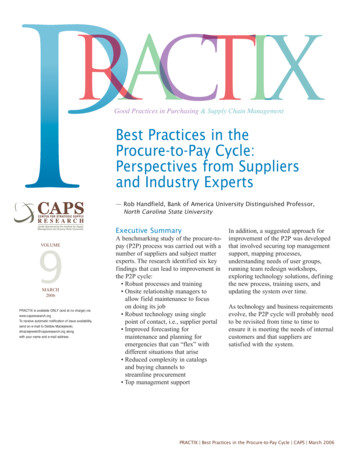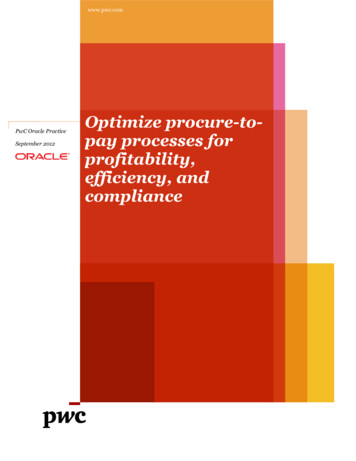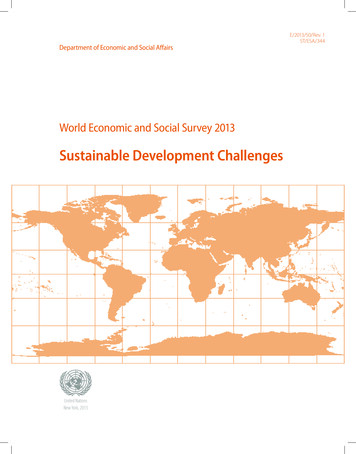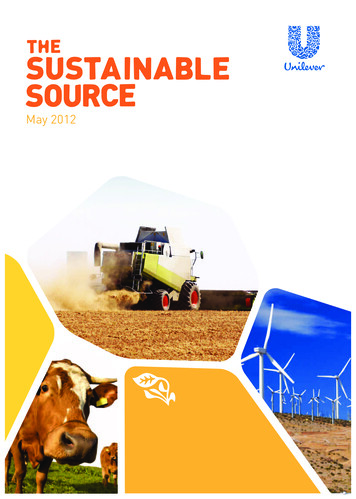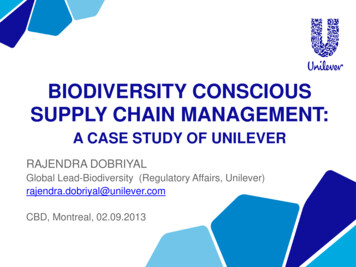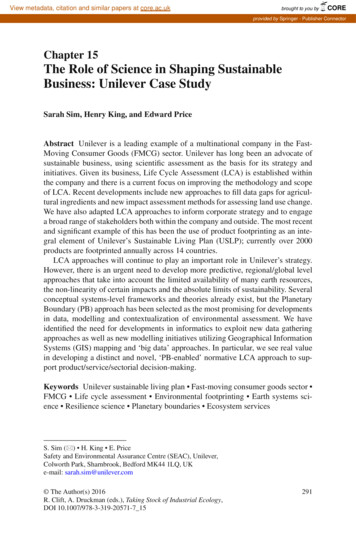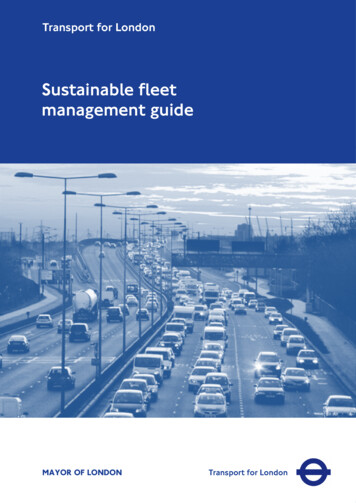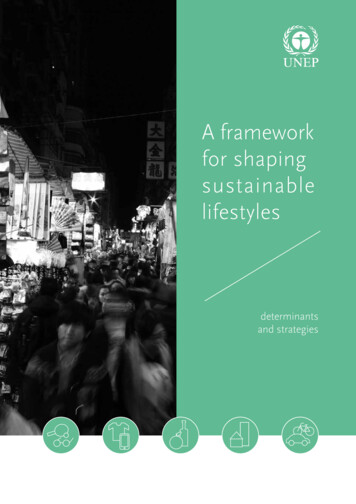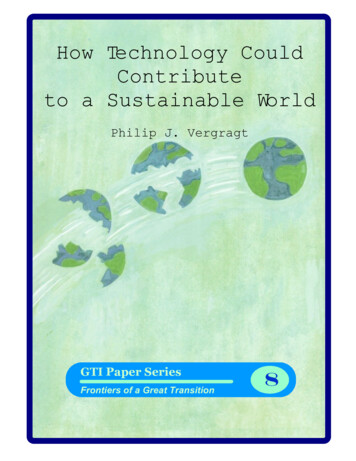
Transcription
MAKINGPURPOSEPAYINSPIRING SUSTAINABLE LIVING
PURPOSE OR SUSTAINABILITY:WHAT’S IN A NAME?There is a lot of talk today about brands with purpose, or sustainable brands,or meaningful brands. The number of descriptions people use is exceededonly by the different interpretations people give them. Some simply meanbrands that support a charity or, say, use ‘natural’ ingredients. At the otherextreme, people set up whole companies whose sole purpose is to ‘do good’.With so many terms in use, it helps to put some definition behindthe terminology.At Unilever we are in the business of helping people to live well and livewithin the natural limits of the planet, so we talk about ‘sustainable living’and ‘sustainable living brands’. For us that means helping to bring aboutgreater social equity and inclusiveness and helping people to: improve their health, nutrition and wellbeingCONTENTSSUSTAINABLELIVING BRANDSmake a positivedifference tosociety and ourcompany purpose reduce their environmental impacts choose products that are better for them, society and the environment.Purpose and productThe concept of ‘purpose-driven’ brands is not new. Among our ownbrands, Lifebuoy and Ben & Jerry’s have had a social or environmentalpurpose at their heart since they were founded. But in today’s complex andinterconnected world, having a powerful purpose is not enough. Brandsmust look at their impacts up and down the value chain and across thepublic domain. For example, they cannot do social good while harmingthe planet or improve the lives of consumers while ignoring the workingconditions of the people who make them.SUSTAINABLE LIVINGPURPOSESUSTAINABLE LIVING03A CONVERSATION WITH KEITH WEED05MAKING PURPOSE PAY: FAD OR FUTURE?09GAINING INSIGHTS, DISPELLING MYTHS11FIVE GOLDEN RULES22DOVE: NURTURING SELF-ESTEEM24BEN & JERRY’S: COMMITTED TO SOCIAL CHANGE26SUSTAINABLE LIVING BRANDS GROW FASTER28GLOSSARY OF SUSTAINABILITY TERMS29SUSTAINABLE DEVELOPMENT GOALSBRANDSThat is why our definition of a sustainable living brand is one that: has a clear purpose that, over time, helps to tackle a social orenvironmental issue or cause produces products that reduce their environmental footprint and/orimprove health and wellbeing or livelihoods.SUSTAINABLE LIVINGPRODUCTSIn Unilever that means sustainable living brands make a positive differenceto society and, ultimately, to our company purpose: Making sustainable livingcommonplace.For a full glossary of sustainability terms, see page 281
DOESPURPOSEPAY?A CONVERSATION WITH KEITH WEED,CHIEF MARKETING & COMMUNICATIONS OFFICERQ: Is the idea of brands with a purpose justthe latest fad or is it here to stay?A: Brands having a sustainable livingpurpose is not a new idea. Unilever’s Britishfounder, William Lever, launched Sunlightsoap in 1880 with the purpose of makingcleanliness commonplace, and there havebeen many more examples over the years.What makes it particularly relevant now isthat the moral case for business to help fixthe fault lines in society and the businesscase for doing so are aligned.Q: What makes you so sure consumersreally want sustainable living brands?A: We have two strong pieces of evidence.Firstly, our own sustainable living brandsgrew 50% faster than the rest of ourbusiness and accounted for more than 60%of our growth in 2016. Secondly, researchwe conducted that asked consumers abouttheir attitudes to sustainable living andcompared what they said against their tillreceipts, showed that over 50% of peoplenow buy or want to buy brands that are moresustainable and we expect this to grow.Q: Why do you think consumers wantbrands with a sustainable living purpose?A:Keith Weed,Unilever’s Chief Marketing& Communications Officer2As marketers, we know that the bestbusinesses understand their consumersintimately as individuals. They are not justa pair of armpits looking for deodorantor a head of hair looking for shampoo,but real people with real lives and realanxieties. People want to engage withbrands that understand them and speak totheir concerns. Having a sustainable livingpurpose enables brands to connect withthem at a deeper, emotional level.Q: How do you encourage more people tobuy these brands?A: The main drivers of sustainablepurchasing are trust and social norms.Consumers need to trust the people whomake the product and they need to feel it isa purchase that is valued by the people theycare about. But they don’t want to pay moreor sacrifice performance. They want greatproducts that are good value for money andsustainable. That doesn’t mean they have tobe new brands. They want the brands theyalready know and love to be sustainable.Research has shownOVER 50%of people now want tobuy brands that are moresustainableQ: Why are you sharing your research andinsights – isn’t this competitive information?A: When we launched the UnileverSustainable Living Plan in 2010 we said thatif we went down the path of creating a new,sustainable business model but only a fewother companies joined us, we would havefailed. So we have committed to helpingother brands and businesses by sharingwhat we have learned about sustainableliving in the hope of inspiring others todo the same. Make no mistake, we seecompetitive advantage in being a first mover.But we also believe that a rising tide lifts allboats, so we want to encourage others tojoin us on our journey.Q: What’s this booklet about and what’s in itfor the marketing world?A: In this booklet, we share the resultsof our Making Purpose Pay research, theinsights it has given us, the lessons we havelearned from integrating sustainability intoour leading brands and the work we havebeen doing to measure their impact onour business. I believe sustainable livingbrands represent a huge opportunity for themarketing world to build strong, sustainablegrowth and enduring consumer relationshipsin an increasingly resource-constrained,transparent and untrusting world. It’s alsoa wonderful opportunity for marketing torediscover its original, noble purpose ofdeveloping brands that are good for businessand good for the world, and reposition ourprofession as a powerful driver of positivesocial change.3
MAKING PURPOSE PAY:FAD OR FUTURE?Brands with purpose or sustainable brands may be talked about a lot but, so far, evidencethat they contribute to growth or increase trust has been thin on the ground.Unsurprisingly, many brand specialistsand marketers remain to be convinced.Do such brands, whatever they are called,really make a meaningful difference? Doconsumers really care about sustainability?Does it drive market penetration or brandloyalty? And, crucially, does having apurpose lead to increased sales?“At Unilever we have put a lot of effort andreputational capital behind our big bet thatconsumers want their favourite brandsto be more than just responsible and willincreasingly prefer brands that connectwith their personal values and concerns,”explains Unilever’s EVP, Global SustainableBusiness & Communications, Sue Garrard.“Or, to put it more simply, people wantbrands to do more good, not just do less bad.“THE SIZE OF THE PRIZE COULD BEMORE THAN US 2.5 TRILLION”4“Consumers are becoming much moreaware of the positive difference brands canmake to social and environmental issuesand also the difference they themselvescan make through their everyday shoppingchoices. This has been fuelled by thegrowth in social media and the opportunityit provides for people to have closer, moreintimate connections with brands. This inturn creates a growing need for brandsto generate content that resonates withtheir consumers’ values. Brands with asustainable living purpose help themdo that.”The say—do gapOver the years a number of research studieshave sought to show a direct correlationbetween brands with a sustainable livingpurpose, or that integrate sustainabilityinto their products, and increased sales.Most surveys that have appeared measureconsumer attitudes or claimed behaviour.These show that consumers say they wantto buy brands whose causes they believe inand claim to prefer products that in someway are better for the environment. “But,as we all know, people don’t always do whatthey say or say what they do,” says Sue, “andthere has always appeared to be a big gapbetween what consumers reply when askedand what they actually do at the point ofpurchase.”Other surveys, notably by Nielsen andthe Boston Consulting Group (BCG), havemeasured sales. An analysis of productsin the United States in 2014 showed that16.5% of US consumer goods were whatBCG called ‘responsible products’ andthat they were growing by 9% each year,outpacing the market. At that rate of growth,they predicted these products would accountfor 70% of total grocery growth in US andEurope by 2019.Until now research has been based either onconsumer attitudes and reported behaviour,or on measured sales behaviour. “So wedecided it was time to carry out bespokeresearch to connect these two typesof research at the consumer level. We wantedto explore the difference between whatpeople say about sustainability and what theybuy, to see how big or small the gap actuallyis, and what barriers need to be overcometo encourage more consumers to buy moresustainable choices more of the time.”Working with the leading data analysiscompany Europanel, and Kantar andGFK’s consumer panels, 10,000 heads ofhouseholds were interviewed across twodifferent categories (tea and laundry) in twomarkets (Turkey, United Kingdom). Datawas gathered on their general and categorysustainability beliefs and behaviours. Over 50questions were asked covering a wide rangeof social and environmental topics, such asrecycling, travel, water usage, energy saving,treatment of workers, opportunities forwomen, responsibility for taking action, andshopping for Fairtrade products.These were mapped against whatthey actually bought and the reasons theygave for their purchase decisions. Thisstudy was then added to by quantitativeresearch with Europanel in Brazil, India andthe United States on attitudes and beliefs toensure our findings were globally relevant,and with qualitative research in the UK,Turkey and Brazil by consumer and culturalinsight agency Flamingo, to understandthe deeper drivers behind the attitudesand purchasing behaviours we observedquantitatively. Across the study, 20,000people were interviewed.Sue GarrardUnilever’s EVP, Global SustainableBusiness & Communications5
MAKING PURPOSE PAY:PAST THE TIPPING POINT“The results were astonishing. They not only show that the majority ofpeople genuinely do care about sustainability, they bust the myth thatthis is still a niche issue. What the study showed was that over half ofall consumers already buy or want to buy sustainably: One in three(33%) already purchases products with sustainability in mind and afurther 21% do not currently but would like to.“This confirmed that the potential for sales growth is even bigger thanwe imagined. If these categories and countries are typical of consumergoods across the world, and we have no reason to believe they are not,then the size of the prize could be a sustainable FMCG market worthmore than US 2.5 trillion, including an untapped market opportunityworth US 1 trillion.”One in three33%already purchases productswith sustainability in mindThe study also found a strong correlation between level of engagementon sustainability and the level of influence on buying decisions.“It confirms that when people say they care, half of them want to go onand do something about it. This is well past the tipping point. We’ve alsoestablished that people with the strongest beliefs are the most likelyto buy.”So what is stopping those that aren’t yet buying sustainably? For the onein five people (21%) who are on the cusp of doing so, three concerns holdthem back: They don’t believe what the brand is saying about sustainability They believe they have to make a sacrifice in product performance They think it will cost them more.“That means if brands can produce products that cost the same,perform the same or better, and deliver authentically on thesustainability message, then they are on to something!” says Sue.6One in five21%do not currently buysustainably but would like to7
GAINING INSIGHTS:DISPELLING MYTHSStan SthanunathanUnilever’s EVP,Global Consumer& Market Insight“These findings have reinforced our belief that sustainability is already a significant contributor to sales growth,” according to StanSthanunathan, Unilever’s EVP, Global Consumer & Market Insight. They also dispel some of the myths around sustainability, such asit being something that only rich people or tree huggers or young people care about. We identified five key insights:1. Sustainability is already mainstream, it’s nolonger nicheWe consistently found high percentage responses to a wide rangeof statements covering attitudes and issues across the breadth ofsustainability. For example, overall three out of four people agreewith the statement “I feel better in myself when I buy productsthat I know are sustainable or better for the environment”.2. Sustainability is a bigger concern in developingmarkets than developedWhile there are differences of degree, the findings areconsistently high across all markets but responses indeveloping markets are even stronger. For example, 53% ofheads of households in the UK and 78% in the US feel better inthemselves when buying products that they know are sustainableor better for the environment, but the number climbs to 85% inBrazil and Turkey and 88% in India.“I feel better in myself when I buy products that I know are sustainable or better for the Kantar World Panel: % Respondents Scoring 6 Where 10 Strongly Agree8In developing and emerging markets the motivation to lead amore environmentally conscious life is higher than in developedcountries. People in these countries are more exposed to thenegative impact of unsustainable practices, such as water andenergy shortages, food poverty and poor air quality, so are morelikely to take action and feel a sense of personal responsibility.And they can more readily see the difference that can be madeif “I do my bit and others do too”. So while Brazilian, Indian andTurkish people are more likely to recommend greener, moresocially responsible products to friends and family and tell themhow important it is, this sense of social pressure is currently lessprevalent in the UK and US.3. Sustainability is of widespread interest, not confinedto a single groupInterest in sustainability among heads of households extendsto all ages and income groups. It is not just millennials, whoseinterest is on a par with other age groups, nor confined tohouseholds with a higher income. We found this surprising andkept interrogating the data to make sure we were not missingsomething. The motivations for people to act sustainably aremany and varied, from restrictions on daily life caused by, forexample, water shortages, or the need to save money on energybills, to simply wanting to feel good about oneself.4. Sustainability requires collective action, notworking in silosAcross the population people know and accept that they havea responsibility to act and believe that if people, governments,companies and brands all act together, we can make a biggerdifference. They also look to companies and governmentsto make a difference too. It is now seen as an obligation forcompanies and brands to act, so failure to do so represents arisk. This idea that everybody has a role has been reinforcedby other research we carried out into consumer attitudes topackaging waste. People see they have a shared responsibilityto reduce it, it is not just down to governments and companies.5. Sustainability alone is not enough, consumerswant it allIt is not enough for a product to be sustainable but less goodthan the best the category can offer in terms of quality and valuefor money. People are not prepared to compromise on efficacy orpay more for the privilege. Consumers want it all. What we arenow seeing is that sustainability drives brand love and thereforebrand preference.These insights highlight that sustainability can no longer beseen by marketing and brand managers as an add-on or anice-to-have. Nor does it only apply to new products or productvariants. Any brand has the potential to become a sustainableliving brand, not just those created with a social purpose by theirfounders, such as Lifebuoy or Ben & Jerry’s. Dove, Vaseline andDomestos are just a few examples of established brands thathave introduced a purpose in recent years.9
CONNECTING WITH CONSUMERS:FIVE GOLDEN RULESOur Making Purpose Pay research and experience of developing sustainable living brandshave helped us identify five golden rules, which in our view represent best practice.DEFINE PURPOSEBUILD TOUCHPOINTSFRIENDS ANDFAMILY MATTER10TAKE ACTIONTALK MY WORLD11
DEFINEPURPOSEA powerful purpose is one where a brand takes on an issue thatis consistent with its beliefs and values, relevant to its products,motivating to its consumers and relevant to society. “It has to havean authenticity about it, ideally tackling a social or cultural issuethat needs resolving”, says Aline Santos, Unilever’s EVP, GlobalMarketing. “We’ve all seen instances of, for example, a food brandsupporting the fight against women’s breast cancer and thought‘where’s the connection?’, as opposed to, say, Lifebuoy, wherethe issue they support and the product they make are both totallyconnected to cleanliness and children’s welfare.”AXEREDEFINING MASCULINITYDIRT IS GOODPLAYING OUTDOORSAxe, known as Lynx in the UK, Ireland and Australia, is amen’s grooming range sold in more than 90 markets. A studyin 2014 of over 3,500 men in 10 countries revealed that menfeel overwhelming pressure to conform to outdated notionsof masculinity. Another study in 2015 showed that 9 out of 10women find men more attractive when they are comfortablebeing themselves, not trying to be something they are not.Unilever’s leading laundry brands, such as Omo, Persil, Skip andVia, sold in over 78 markets, are collectively known as Dirt is Good(DiG), which reflects the insight that children today are no longerfree to get dirty and so they cannot fully experience life.It has to be an issue where the brand can make a tangible,measurable and meaningful difference and is able to take actionon a scale that is in proportion to its size and reach. It has to bemotivating to the brand’s target audience, relate to the product, drivebrand equity and contribute to sales.“Creating a powerful purpose that meets all these criteria is difficultand it is not always easy to get it right from the start,” reassuresAline. “Brands should not be afraid to evolve their purpose as theylearn more about the issue and as the issue itself evolves.”The Sustainable Development Goals (SDGs) are a good startingpoint in helping to identify relevant issues brands can fight for.These cover social needs in countries around the world, not just indeveloping countries (See page 29).These insights led Axe to develop a new sustainable livingpurpose which aims to empower men to express theirindividuality, becoming their most attractive selves. Thisnew purpose was launched in 2016 with a broader rangeof male grooming products to help men develop theirindividual style, and a partnership with three NGOs: Ditchthe Label, Promundo and The Representation Project.12Aline SantosUnilever’s EVP, Global MarketingThe majority of children (56%) worldwide get one hour or lessof outdoor play a day, and nearly 1 in 10 children never playoutside. This is due to a variety of factors, ranging from therise in screens to concerns around safety to the pressure foracademic achievement. Without more opportunities to playoutside, parents everywhere are concerned their childrenare missing out on the most important things in life. So DiG’ssustainable living purpose aims to restore childhood andenable children to experience real play, every day.Working with child behavioural experts, parents and teachers, DiGsupported Outdoor Classroom Day, a global campaign to celebrateand inspire outdoor learning and play, in 2016 and 2017. More thana million children have taken part so far and the brand’s ambitionis to get many more playing and learning outside the classroomby 2020.13
TAKEACTIONIt is not enough for a brand just to talk about its purpose consumers expect action too! It takes time to create a significantimpact on a social issue, so it is important to get going, keep goingand sustain action over a period of time. There is nothing thatundermines trust more than to trumpet a new purpose or approachto sustainability, only for the idea to sink without trace a year ortwo later.Setting an ambitious but achievable target helps to demonstrateintent and provide proof of progress. It doesn’t matter if progress isslow at the beginning. “What the research shows is that providingyou are honest about what you are doing and that you have a planto grow, people are prepared to go with you. That’s better than nottalking at all because you don’t think the numbers are big enough,”explains Aline. “People like to be taken with you on the journey, nottold about it afterwards. If you do have a problem or need to alterdirection, providing you maintain an open and continuous dialogue,people accept it and even admire your efforts all the more, becausethey know this isn’t easy and it shows humanity in the way the brandis managed.”It almost always makes sense to work in partnership with anorganisation that is already involved in the issue the brand seeks tosupport, such as a non-governmental organisation (NGO), a likeminded business or a government body. “Sometimes a cross-sectorapproach involving the brand, an NGO and a government can be thebest solution,” advises Jeff Seabright, Unilever’s Chief SustainabilityOfficer. “Engaging government and NGO partners brings multiplebenefits: deep expertise, local knowledge, additional resources andcredibility. This allows us to achieve much more together throughthe brand than we could ever achieve alone. Seeing that a third partyis involved can also work as a validator of the action for consumers,acting as a short-cut signal that the work must be important for theorganisation to want to be associated with the brand.”14Jeff SeabrightUnilever’s ChiefSustainability OfficerLIFEBUOYHELLMANN’SMAKING HANDWASHING A HABIT ON THE SIDE OF FOODLifebuoy soap was launched in 1894 to ‘save lives’ at atime when cholera and dysentery in Britain’s slums werecommonplace. Its sustainable living purpose is the same todaybut on a much bigger scale: To save lives by changing thehygiene behaviour of 1 billion people by 2020. Handwashingwith soap is one of the most cost-effective ways to reduce childmortality and encouraging people to adopt this habit couldprevent 600,000 child deaths every year.Working with a variety of partners, including DFID, PSI,Oxfam and WSUP, Lifebuoy is taking action in 29 countries,including 8 of the 10 countries where infant mortality ishighest. Its flagship School of 5 programme works withteachers to encourage schoolchildren to wash their handsat key moments of the day, with the help of fun materialssuch as comics, posters, diaries, enrolment cards andprizes. Parents are also involved, as families are importantin helping to reinforce handwashing behaviour whenchildren get home from school. Between 2010 and 2016,379 million people were reached. Lifebuoy also runs a neo natal programme, teaching new and young mothers aboutthe importance of using soap before handling their babies.The brand is also raising awareness of the importance ofhandwashing with soap as a public health issue throughits campaign, Help a Child Reach 5. This harnesses thepower of social media to inspire millions of people tosupport Lifebuoy’s work and the power of advocacy topersuade politicians and other leaders in society to investin handwashing programmes.In a world where food is under attack from all sides and isbecoming a source of anxiety for many, Hellmann’s sees itssustainable living purpose as being to champion real food and thepeople who grow and harvest it.The brand is working with farmers to put in place responsiblefarming practices, such as the use of cage-free eggs in itsmayonnaise and sustainably grown tomatoes in its ketchup.Hellmann’s is also setting up Blue Ribbon open farms to helppeople learn more about where food comes from and how itis grown.In 2015 Hellmann’s opened its doors for the first time toone of its tomato farms in Latin America, connectingparents and children with real farmers, some of whom livestreamed from their tomato fields with cameras on theirhats. This helped people to see and appreciate the journeyfood goes through to reach their plates. In two weeks, therewere 80 million interactions with consumers in 3,500 citiesin 110 countries and a 10% jump in market share whichtransformed ketchup sales in Latin America.In 2016 Canadian city children and their parents were invitedto visit a Hellmann’s Blue Ribbon canola (rapeseed) farm tolearn about their food and where it comes from. By showingthe inner workings of a sustainable farm, they were ableto see how tasty food can do good too. The film of theirexperience was seen over 9 million times on digital media.15
TALK MYWORLDPeople care most about people and issues relating to their personalworld – ‘my world’ – rather than the wider world – ‘the world’. Thatmeans they are more interested in social and environmental issuesthat directly touch them and their families rather than more distantissues that do not affect them. So brands that communicate theirpurpose in a way that is too far removed from people’s everyday livesrisk failing to capture their interest.SEVENTH GENERATIONREDEFINING CLEANVASELINEHELPING TO HEAL SKINSeventh Generation is a purpose driven brand based inBurlington, Vermont, that makes and sells home and personalcare products made with plant-based ingredients. These rangefrom bio-based laundry detergents and dish soaps to organiccotton tampons and hypoallergenic baby wipes. Founded in 1988,the company became part of Unilever in 2016, with the sustainableliving purpose ‘to inspire a consumer revolution that nurtures thehealth of the next seven generations’.A high percentage of the conditions that health workers see intheir clinics in frontline situations, such as humanitarian crises,are skin problems that a simple product like Vaseline couldheal and prevent, if only it were available. So, in 2015, the brandcreated The Vaseline Healing Project with an ambitious goal:to help heal the skin of 5 million people affected by poverty oremergencies by 2020.That is not to say that a brand can only support local issues. Somebrands can credibly support a ‘the world’ issue but it is important tofind an insight that brings it closer to home. Often, finding a humanangle makes it easier for people to relate to an issue, such as theenvironment, that can otherwise seem too big or remote.To involve consumers in an issue that is outside their experience orin another part of the world, an emotional connection needs to bemade between the person buying the product and a person or groupof people affected by the issue. For example, concern for children’swelfare can concertina ‘my world’ and ‘the world’. A parent who seesa child in need feels immediate empathy, whether the child liveslocally or on the other side of the world.In fact, having a sustainable living purpose is providing brands with anew way to connect with their consumers at an emotional level.Early on, Seventh Generation products were bought primarily bygreen-leaning consumers who believed in their purpose and theissues they advocate for. As their products became more andmore effective, however, they saw an opportunity to persuademainstream and conventional buyers that products made withplant-based ingredients can perform, in many cases, just as wellas conventional brands.The potential impact consumer products have on our worldand environment can be rather complex and technical. Soto create an emotional connection and make this subject acloser-to-home ‘my world’ issue, the brand enlisted actor,mother of four and Seventh Generation loyalist, MayaRudolph, to use humour to help consumers think again aboutwhat ‘clean’ means. In a series of TV commercials and adigital campaign, she asked the question: “What do strangesmells and crazy colours have to do with clean?”16This campaign led to a 20% increase in households buyingSeventh Generation products and a significant increase inbrand trust and brand equity attributes such as ‘safe for meand my family’ and ‘helps make my home a healthier place’.The Vaseline brand found an authentic way to linkconsumers in ‘my world’ to people in ‘the world’, byhighlighting that the ordinary tub of Vaseline Jelly in theirbathroom cupboard is the same as the one that can make anextraordinary difference in helping to heal the skin of peopleliving in crisis and disaster situations. In its TV campaign,the brand leveraged this insight to create empathy byjuxtaposing ordinary consumers using Vaseline products athome with people living in difficult situations, both using it tohelp heal their cracked skin.The Vaseline brand found that when people start to careabout an issue, they want to be part of the solution, but areoften overwhelmed by the scale of the problem or lack ofways to help. So The Vaseline Healing Project made it easyto get involved by using a ‘buy one to heal one’ promotion;every product purchased triggered a matching productdonation to Vaseline’s global partner, the humanitarian NGODirect Relief.17
FRIENDS& FAMILYMore than ever before, people respond to how they are seen andwhat society, friends and family expect of them. We know that halfof the consumers who are concerned about sustainability issuesalso buy sustainably but that leaves half who are not yet lett
In Unilever that means sustainable living brands make a positive difference to society and, ultimately, to our company purpose: Making sustainable living . sustainable choices more of the time.” Working with the lea
